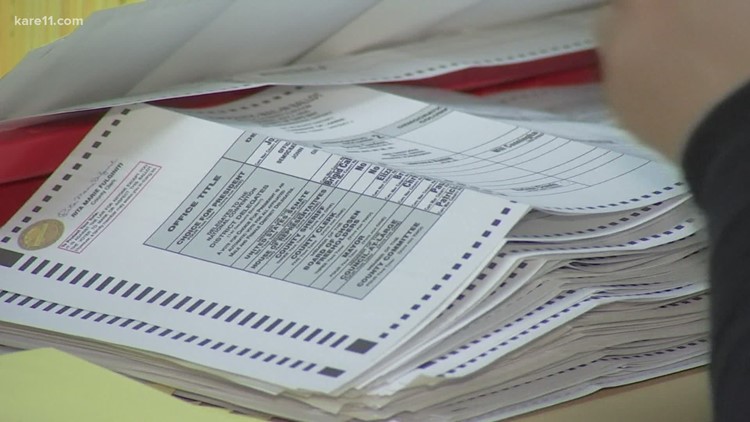Despite buzzing nationwide conversation around mail-in voting and concerns about COVID-19 spread, a new poll shows most Minnesotans plan to vote in person.
The KARE 11/MPR News/Star Tribune Minnesota Poll, conducted by Mason-Dixon Polling & Strategy, Inc., surveyed Minnesotans who said they were likely to vote in November.
Mail-in vs. in person voting
A significant majority of Minnesotans, 61%, said they plan to vote in person. Twenty-six percent plan to vote by mail, 12% will drop off their ballot and 1% are not sure yet.
People in the Twin Cities metro were the least likely to vote in person at 50%. Thirty-one percent said they will vote by mail, and 17% plan to drop off a ballot in person.
Northern Minnesotans were the most likely to vote in person at 69%, with 19% planning to vote by mail and 11% planning to drop off a ballot. In southern Minnesota, 65% of voters said they'll vote in person, 28% by mail and only 5% by dropping off their ballot. The metro suburbs also have a large majority of residents planning to vote in person at 64%, with 23% voting by mail and 12% dropping off ballots.
Some significant disparities can be seen along party lines, with Republicans much more likely than Democrats to vote in person (78% vs. 46%).
Although public health guidance states that older adults are more vulnerable to severe cases of coronavirus than young people, those ages 50 and up are more likely to vote in person (64%) than those under 50 (56%).
Non-white people are slightly less likely to vote in person (57%) than white people (61%), less likely to vote by mail (25% vs. 26%) and more likely to drop off a ballot by hand ahead of Election Day (15% vs. 12%).
Finally, the single greatest indicator of whether a Minnesotan will vote in person or by mail appears to be who they're voting for. People who said they'll vote for Donald Trump for a second term are the most likely of any group to vote in person, at 83%.
Alternatively, people who plan to vote for Joe Biden for president are the most likely to vote by mail (37%). They're also the second most likely to drop off a ballot (18%), only lagging behind Democrats as a whole in that category (20%).
MAIL-IN BALLOT SECURITY
Voters were also asked if they believe mail-in absentee ballots in Minnesota are vulnerable to significant fraud, or have adequate protections in place against significant fraud.
Half of Minnesotans said they believe mail-in ballots are protected, while 41% think they're vulnerable and 9% are not sure.
People in the metro are more likely to have faith in mail-in voting, with 59% of Hennepin and Ramsey County voters saying they believe the ballots are protected.
Southern Minnesotans had the second-highest rate of faith in mail-in ballots, with 54%. In the metro suburbs, 50% of people believe mail-in ballots are vulnerable to fraud, and in northern Minnesota, 52% questioned the security. Ten percent of voters in out-state Minnesota as a whole are undecided on this issue.
There is some political division on the topic of mail-in ballot security as well, with 64% of Republicans believing them to be vulnerable to fraud, and 64% of Democrats confident that they are secure. Independent voters are more likely than not to believe mail-in ballots are safe, at 54%.
Among those who said they'll vote for President Trump in November, 70% believe mail-in ballots are vulnerable to fraud. Seventy-two percent of those who support Joe Biden for president believe mail-in voting is protected.
People with a college degree are more likely to believe mail-in ballots are protected, at 56%, compared to 45% of people with no higher education.
The KARE 11/MPR News/Star Tribune Minnesota Poll was conducted via phone by Mason-Dixon Polling and Strategy, surveying 800 registered Minnesota voters by phone (both landline and cell) from Sept. 21-23, 2020.
The poll has a margin of error of plus-or-minus 3.5 percentage points. That means there is a 95% probability that the "true" figure would fall within that range if every single voter were surveyed. The margin of error is higher for subgroups like age and gender.



